Menu
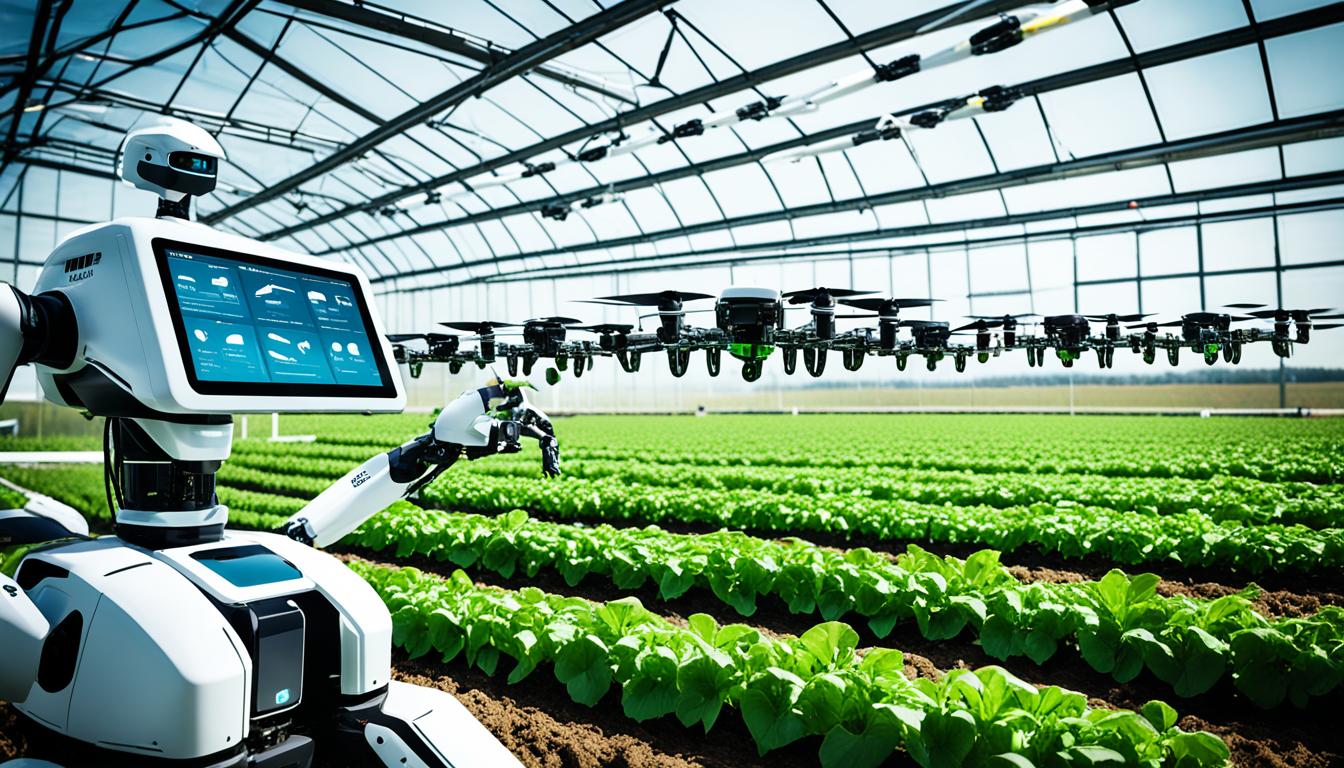
Did you know the agricultural robotics market hit a whopping USD 14.9 billion in 2022? This huge figure shows the industry is thriving and set to grow fast. It’s expected to grow more than 15% every year from 2023 to 2032. This rapid growth will change farming in big ways.
The need for technology that saves on labour is growing. Older farmers are retiring, and the young aren’t keen on hard farm work. Robotic help is becoming a must. These robots have advanced tech like sensors, GPS, and AI. They do many farm jobs well, boosting productivity and saving resources.
In 2022, drones topped the market, making over USD 7 billion. They are expected to keep growing at more than 17.5% each year. This shows how drones and other high-tech tools are changing farming. Precision agriculture, which was a big part of the market in 2022, is a great example. It shows how technology is improving farming methods.
North America led with over 30% of the market share in 2022. Key players include Agrobot, AGCO Corporation, AgEagle Aerial Systems Inc, and Blue River Technology. They are at the forefront, introducing new ways to improve farming.
Agricultural robots, also known as agribots, bring a new era to farming. They are designed for tasks like planting, harvesting, spraying, and checking crops. These machines show the best of farming automation. They use sensors, GPS, and AI to work without human control. This change is revolutionising the farming world.
Agribots aim to make farming less hard and time-consuming. They take on jobs like planting and harvesting so farmers can focus on more important things. For example, a robot by Harvest CROO picks a strawberry plant every eight seconds. Then, it moves to the next in just a second and a half. This shows how quickly agribots can work, making farming much more efficient.
The need for robots in farming came from a lack of people to work, especially as farm workers got older. Companies began developing robots to help, like Tortuga AgTech with their highly accurate fruit pickers that need only one person to supervise. Also, Carbon Robotics made the LaserWeeder. It uses AI to remove weeds without hurting crops. These are big steps in farming automation.
Today, everyone sees these high-tech tools as key to farming. They make farming work better and in a more eco-friendly way. For instance, Nexus Robotics’ R2Weed2 doesn’t just remove weeds. It also checks the soil. This shows how much smart farming tech has improved farming, making it more productive and better for the planet.
The agricultural robotics market has seen big growth lately. By 2023, it reached a value of USD 9.0 billion. This jump shows how much farmers are turning to self-driving farming tools.
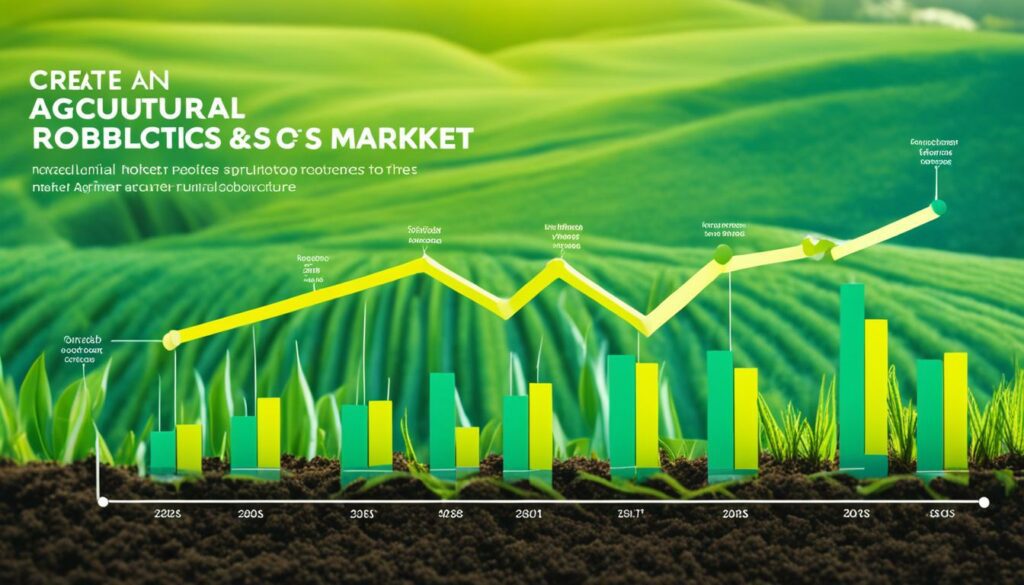
In 2023, the market’s worth was USD 6030.18 million. Important areas like Asia Pacific and North America play a big part in its success.
From 2024 to 2032, experts predict a grow rate of 16.1% every year. By 2032, they expect it to hit USD 35.7 billion. That’s a massive leap.
Why is the market booming? The need for technology to help ageing farmers is one reason. Also, better robotics are making farming more precise and efficient.
Here’s how the market is expected to change over time:
| Year | Market Size (USD Billion) | CAGR (%) |
|---|---|---|
| 2023 | 9.0 | – |
| 2024-2032 | 35.7 | 16.1 |
The drive for better farming technology and demand for precision will keep pushing the market up. As a result, the agricultural robotics industry will flourish in the next ten years.
The field of agricultural robotics is changing fast. Many factors create this change. These include the need for robotic solutions and the obstacles they face. This journey is challenging but also full of potential.
One key reason for the growth of agricultural robotics is the lack of farmworkers. Older workers are retiring, and the younger ones aren’t stepping in. Robotic solutions step in to fill this gap, boosting productivity. They allow farms to use resources more efficiently, cut waste, and grow better crops.
Despite its benefits, agriculture robotics still face challenges. The biggest one is making systems that can work without human control across different and unexpected farm terrains. This process is both complex and costly. Adding to this is the issue of handling data in real-time and the ongoing need for innovation.
The industry’s growth is evident, especially in areas like unmanned aerial vehicles (UAVs). As shown in FIGURE 15, this field is expected to grow the fastest. Moreover, FIGURE 18 shows the Asia-Pacific region leading this expansion.
| Year | USD Exchange Rates |
|---|---|
| 2019 | 1.12 |
| 2020 | 1.10 |
| 2021 | 1.13 |
| 2022 | 1.14 |
Big steps forward in agricultural robotics use new AI and sensors. This progress makes farming more efficient and accurate.
Advanced sensors are vital in farming robots. They help collect data in real time, which improves how tasks are done. AI makes robots better at analysing data and doing jobs like controlling pests.
AI is key to making these robotic tasks possible. It helps these machines understand their surroundings and react quickly. This shows how important AI is in shaping the future of farming.
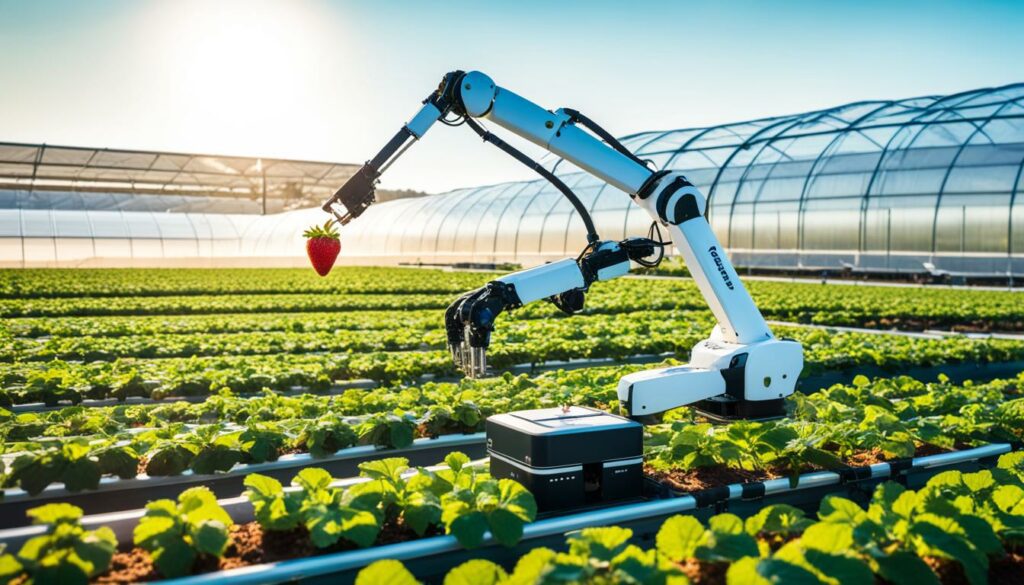
Robotic solutions in farming are expanding rapidly. They include autonomous tractors and drone seeders. These new technologies are changing how farms are run.
John Deere’s self-driving tractors use GPS to work without much human help. They make planting and harvesting easier and more precise. Also, drones can plant trees at an amazing rate, transforming how forests are managed.
New crop technologies are also catching attention. For example, Croptracker’s tech lets growers check apples quickly for quality. This speeds up sorting and lessens waste. The Agrobot™ makes strawberry picking easier, which helps farms in the huge strawberry market.
These examples show the wide range of use for modern farming robotics.
The COVID-19 crisis caused big changes in many areas. Agriculture was not spared. The pandemic showed how important farming automation is. It helped activities like planting and harvesting continue smoothly during lockdowns and social distancing.
Because fewer workers were available, there was more need for robots. The market for these machines was worth about USD 14.9 billion in 2022. It showed strength and flexibility. Experts think it will grow more than 15% each year from 2023 to 2032.
Lots of money and new ideas flowed into the agricultural robot sector during the pandemic. Big names like Deere & Company and Blue River Technology saw a big demand for their products. Blue River Technology, for example, introduced a top-notch self-driving system for farming in June 2023.
Also, drones made good money, over USD 7 billion, in 2022. They became key in farming – watching crops closely and aiding in their care. The use of drones is projected to grow by over 17.5% in the coming years.
In 2022, North America led in using agricultural robots, with over a 30% share. An older workforce and the desire for new tech helped this leap. This leadership suggests a larger trend: a strong move towards automation and robotics in farming.
Looking ahead, the market for agricultural robots is set for more growth. With more money and new technology, robots are becoming vital for the future of farming.
Data-driven farming is changing agriculture with high-tech tools. It gathers lots of data using smart sensors and cameras. This data is key for better farming practices.
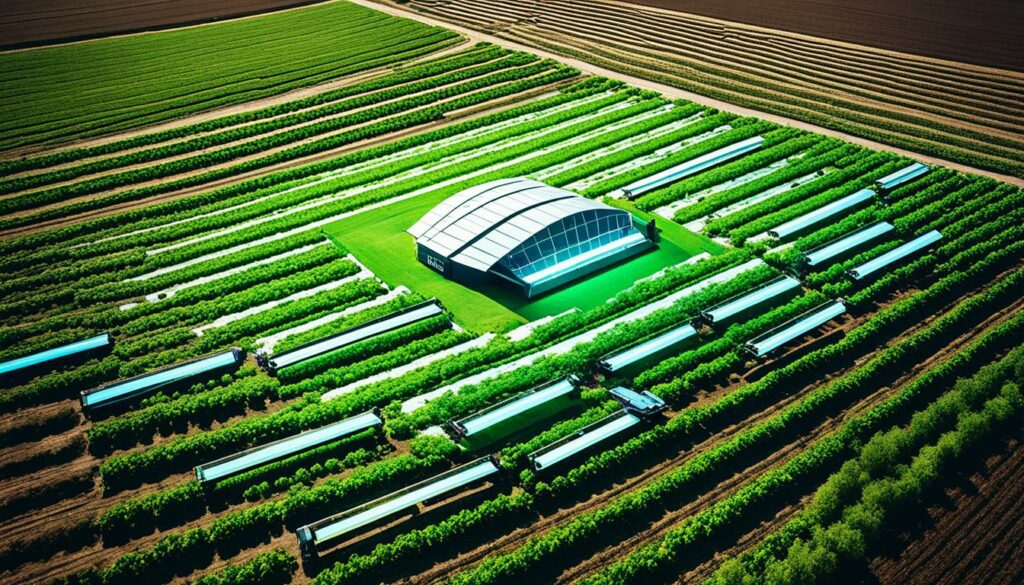
In modern farming, sensors and cameras are vital. They collect info on soil, weather, and plants. This information helps in running farms better and in a greener way.
After collecting data, it’s analysed with advanced AI. This smart farming data analysis helps farmers decide on things like when to water, how to control pests, and where to put fertiliser. These data-driven farming techniques make farming more precise and increase productivity.
Now let’s look at some important numbers showing how this tech is growing:
| Statistic | Details |
|---|---|
| Agriculture Robots Market size (2022) | USD 14.9 billion |
| Estimated CAGR (2023-2032) | Over 15% |
| North America Market Share (2022) | Over 30% |
| Precision Agriculture Application Segment Market Share (2022) | Over 25% |
| UAVs/Drones Segment Revenue (2022) | Over USD 7 billion |
| Expected CAGR for UAVs/Drones Segment | Over 17.5% |
Agricultural robots are changing how we farm today. They boost efficiency and precision from monitoring crops to harvesting. These robots are improving farming’s future.
Agricultural drones are now vital for farmers. They monitor crops in real-time and analyse data, supporting precision farming. They offer clear views from above, spotting crop problems, water needs, and pests fast.
Driverless farm equipment is altering how we farm. This includes self-driving tractors and harvesters. They plant, fertilise, and harvest with great precision, lessening mistakes and increasing output. For example, FFRobotics’ fruit harvester works ten times quicker than a person.
Automatic milking systems are also upping efficiency. They milk cows without direct human involvement, which boosts milk production and cuts labour costs. AI and sensors ensure cows are milked at the right times, improving the herd’s health and productivity.
Automated harvesters are crucial in agriculture. For instance, Tortuga AgTech and Harvest CROO have advanced robots for picking fruit. These robots are highly accurate and fast. Tortuga AgTech reaches 98% accuracy with little oversight. Harvest CROO’s robot, meanwhile, picks strawberries in seconds, making harvesting much more efficient.
Agricultural robots are changing how we farm today. They use the latest tech to improve farming in many areas.
Precision agriculture is a major use for these robots. They use data, GPS, and sensors to work precisely. This helps save resources and improves productivity in planting and weeding.
In livestock farming, robots are making big changes. They handle feeding and monitor animal health without constant human supervision. This is key for taking care of animals and making farms run better.
Robots have hugely improved dairy farming, especially in milking. Now, milking robots are very popular. They make milking more efficient and keep track of cow health for better milk yield.
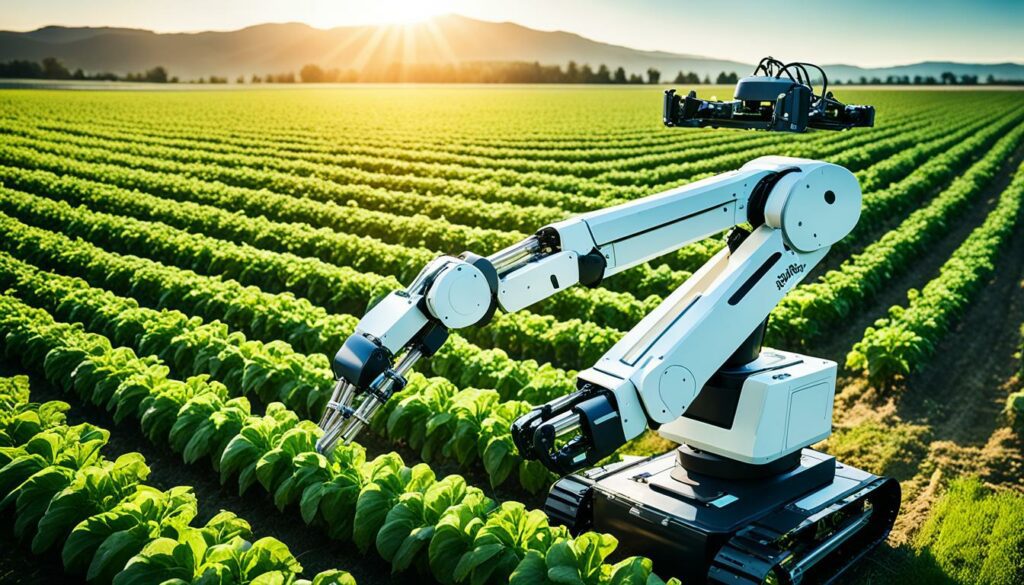
In harvesting and threshing, robots solve the problem of not enough workers at busy times. These robots harvest and process crops quickly and well. This boosts productivity and cuts down on losses after harvest.
Robots in indoor farming are tackling the issue of less land for crops. They control the whole process, from planting to harvesting. This makes farming more efficient and can happen all year.
Consider the global agricultural robotics market snapshot between 2023 and 2028:
| Year | Market Value (USD billion) | Key Growth Segment |
|---|---|---|
| 2023 | 13.4 | Dairy Farming (48.6% share) |
| 2028 | 86.5 | Unmanned Aerial Vehicles |
Precision agriculture is changing farming with new technologies. It helps farms work better, saves resources, and grows more crops. In 2023, only 27% of U.S. farms were using it. But, the good it can do makes it important for future farming.
The USDA and the National Science Foundation gave about $200 million for research between 2017-2021. This money helped a lot in making precision farming better.
Precision agriculture makes farms run more efficiently. For example, the AutoProbe can check 150 acres of soil in just one hour. This quick and precise way of looking at soil helps farmers use fertilisers better, which reduces waste.
This kind of farming also means using fewer resources. New devices, like precise sprayers, help fight weeds without using too much weed killer. Agricultural robots plant seeds very carefully, meaning farmers don’t use too many seeds. This all helps reduce waste and protect the environment.
Precision farming leads to more crops. Without it, weeds can cut crop growth by over 50%. But with precision farming, this drop is much less. Plus, using robots for planting helps control pests and encourages more plant types. This also boosts the number of crops that can grow in a field.
Even though precision agriculture is very helpful, there are some challenges getting in its way. These include the high cost to start, worries about who owns the data, and the lack of common tech rules. To solve these, it’s suggested to help farmers more with money and to create better tools to show the benefits of this tech. Doing this, we help farming become smarter and greener. It also meets the goals of the farming field today.
The North American agricultural robotics market is key on the global stage, holding over 30% of the market. This success comes from high farm wages leading to labour shortages. The region focuses on new tech, especially agricultural robotics in the United States. Here, precision agriculture led with over 25% market share in 2022.
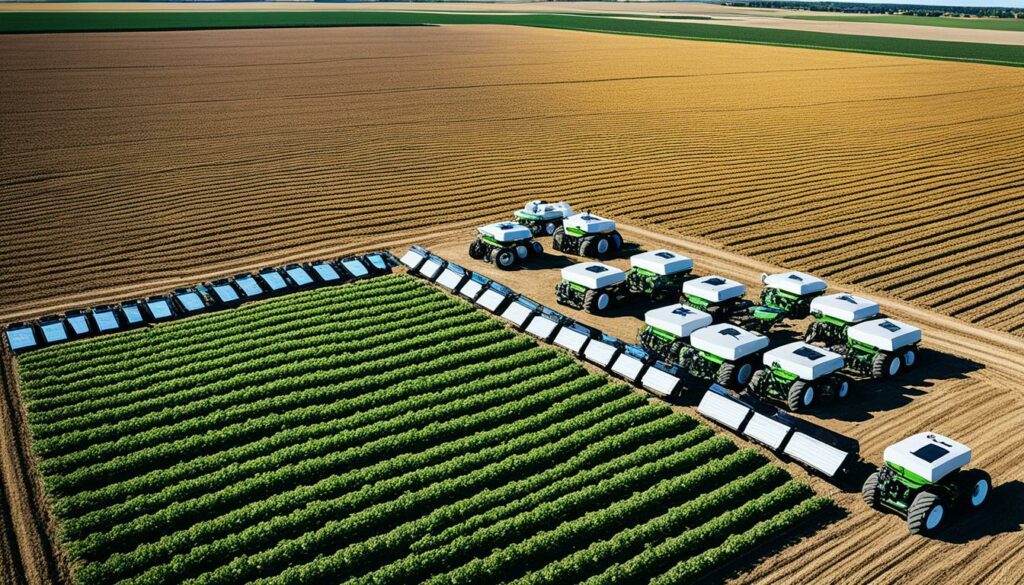
In the U.S., the agricultural robotics market was worth USD 14.9 billion in 2022. It’s set to grow over 15% yearly from 2023 to 2032. This growth is powered by the rise of UAVs or drones, reaching over USD 7 billion in sales in 2022. Innovators like Blue River Technology, a John Deere brand, are key with products like the See & Spray Ultimate machine.
Government help is vital for the North American agricultural robotics market. They give out agricultural technology incentives to push robotics on farms, fighting labour shortages. This boost is especially needed in high-wage places like California. The government-tech teamwork boosts North America’s farms, promising great growth. By 2033, the market is set to hit USD 86.5 billion, up from USD 13.4 billion in 2023.
The European agricultural robotics market is growing fast. With the top manufacturers in the region, it’s leading in innovation and distribution of new tech.
In Europe’s robotics market, big names like Agricon, Naïo Technologies, and Bosch stand out. They’re pushing the use of robotic tech in farming. For example, Naïo has built weeding robots that use smart sensors and AI. They’re efficient in weeding crops. Bosch, on the other hand, shines with its accurate spraying tech. This helps farms take better care of their crops.
Europe is quick to adopt new farming technologies. More farms are using self-driving tractors and aerial drones. This shift is supported by farm subsidies and government help. These technologies boost farm work without harming the environment.
The market in Europe is improving fast thanks to these tech leaders. It’s getting ahead in the world market.
| Manufacturer | Key Technologies | Country |
|---|---|---|
| Agricon | Autonomous Systems, AI | Germany |
| Naïo Technologies | Weeding Robots, Advanced Sensors | France |
| Bosch | Precision Spraying, UAVs | Germany |
The agricultural robotics industry competition is heating up. Market leaders like Deere & Company and AGCO Corporation are competing in new ways. They are investing in research, making strategic moves, and partnering up to create the next big thing. This shows the world of farming is quickly moving towards more technology.
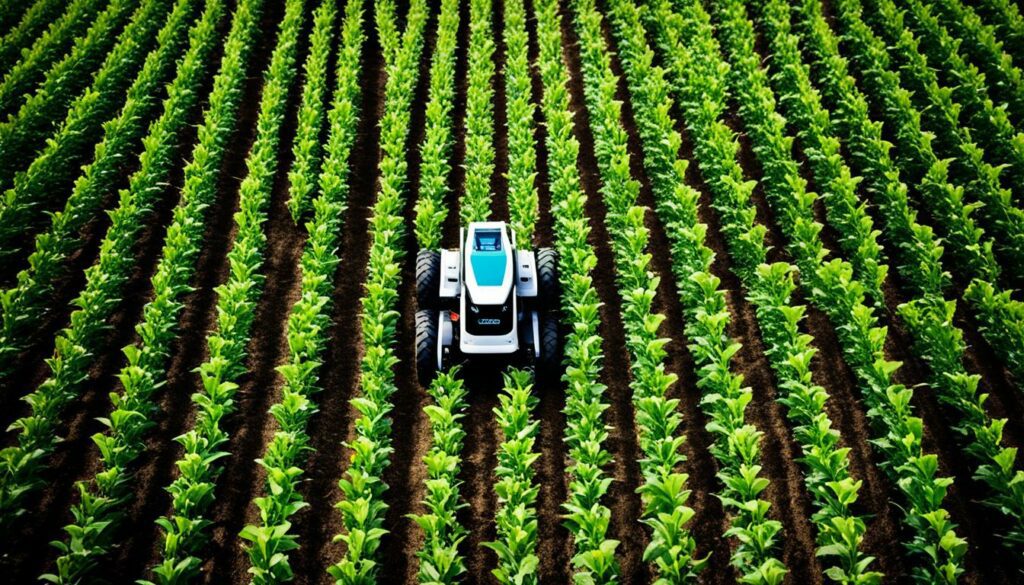
In the last ten years, we’ve seen a big rise in new patents for farm robots. This shows how focused the industry is on getting better through new tech. By 2024, the market is set to hit USD 14.97 billion, jumping to USD 27.71 billion by 2029. That’s a growth rate of 13.10% each year.
What sets the agricultural robotics market leaders apart is how unique and new their solutions are. For example, Agribotix LLC and Agrobot are known for their top-notch robotic systems. They use the latest AI and sensors to make farming more efficient and productive.
Next year and beyond, we’re going to see some big events in the industry. This includes key conferences where experts and companies will share and learn new things. Such events help in announcing new products and making important partnerships that push the field ahead.
But, there are some big challenges to face, like the high costs of new tech and the risks that come with it. Still, support from governments and a growing use of AI are opening up more chances for the industry to grow.
Europe is leading the way in adopting new technologies, making it the fastest-growing market. Meanwhile, North America is ahead in market size. It benefits from advanced farming practices and government help. These facts make the competition fiercer, pushing companies to always come up with something new to stay ahead.
| Key Players | Major Strategies | Region |
|---|---|---|
| Deere & Company | Research, Product Launches | North America |
| AGCO Corporation | Strategic Investments, Collaborations | Global |
| Blue River Technology | Innovation, AI Integration | North America |
| Agrobot | Technological Innovations | Europe |
| Agribotix LLC | Precision Farming Solutions | Global |
The world of agricultural robotics is stepping up with new advancements and product releases. The See & Spray Ultimate by Blue River Technology is a notable example, marking a big step in weed control. This shows how important it is for robotics to tackle modern farming challenges and boost efficiency.
New robots are changing the way farming works. Milking robots, for example, are now a big part of dairy farming, making up 48.6% of the market. Experts predict the market will grow to USD 86.5 billion by 2033. This shift towards autonomous farming gear, including drones and driverless tractors, proves the industry’s focus on getting more done with less effort.
Working together is helping to drive innovation in agricultural robotics. Tech companies and farming specialists are teaming up to create advanced tech solutions. These alliances are behind products like automatic tractors that lead the market in hardware sales, at over 55%. They show how teaming up can push new technologies faster, helping everyone.
From 2023 to 2033, the agricultural robotics industry is predicted to grow by 20.5% every year. This major growth is thanks to ongoing progress in robotic farming gear and smart alliances. With new high-tech products entering the scene, the future looks bright for the industry.
The agricultural robotics market includes special machines and technologies. These are made for farming tasks like planting, harvesting, and pest control. They use high-tech stuff like sensors, GPS, and AI.
Farming robots were first created to tackle labour shortages and boost efficiency. As time went on, they improved to meet the needs of modern farming. The use of advanced tech in farming has increased to address industry demands.
In 2022, the market was worth USD 14.9 billion. It’s set to grow at over 15% every year from 2023 to 2032. This growth is mainly due to ageing workforces in farming and the rise of autonomous equipment.
The market is growing because of the need for more workers, higher productivity, and better farming. Farmers want more efficient and precise ways to farm, which is why they’re adopting more robots.
One big challenge is making robots that work well in all kinds of fields. It’s tricky because not all fields are the same. Also, making sure these robots can rely on sensors and AI is difficult for wide use.
Top-notch sensors and AI have made farming robots very useful. They help with jobs like keeping pests away and monitoring fields. This makes farming more precise and better.
COVID-19 made the need for farming robots more urgent. With lockdowns and distancing, farming couldn’t rely on people as much. This led to more investments in robot technology to keep farms going.
Farming now uses sensors and cameras to gather lots of data. This data is put through AI to make smart choices in farming. This helps with things like keeping away pests and watering just the right amount.
There are many types, from drones for watching fields to tractors that steer themselves. There are also machines for picking crops and milking cows. All these robots make farming more efficient.
Farming robots are used in things like making crop production more precise. They also help with looking after animals and plants. All this leads to better farming yields and saves on resources.
Precise farming makes farms more efficient and cuts down on waste. It uses just the right amount of things like water, fertilisers, and pesticides. This saves money and is kinder to the planet.
In North America, high labour costs and a lack of skilled workers push for more robots. The US, in particular, is keen to use farming robots. This is because they promise to make farms more efficient and greener.
Europe grows in this market thanks to its strong manufacturers and love for new tech in farming. It’s also supported by the government. Innovations like self-driving tractors and drones are popular. They help bring more farming robots to the field.
Strong companies in this market include Agrobot, AGCO Corporation, and Blue River Technology. They work hard to stay ahead by investing in research and making new products. This helps them grow and win more of the market.
Blue River Technology’s See & Spray Ultimate machine is a big deal in fighting weeds. It’s just one example of how companies coming together can create exciting new solutions. These steps are important for making the market bigger and better.